The sound of a working hood can be loud, more than 45 dB. With this noise level, it is difficult to fall asleep or do your usual activities. To reduce the noise of the hood in the kitchen, sometimes it is enough to insulate the air duct, be more careful about the selection and installation of the device.
Noise level
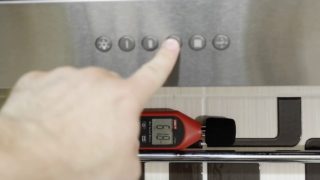
The noise of the device depends on its power. A more productive device works louder. The noise level of the hood for the kitchen is 50-60 dB at maximum speed. 50 dB is given by a device with a capacity of 500 m3 / h, 60 dB - 600-1000 m3 / h. For comparison, the level of intensity of sounds:
- whisper - 20 dB;
- quiet speech - 30–40 dB;
- loud speech - 60–70 dB;
- the hum of a passing car - 70-80 dB.
With prolonged noise above 80 dB, headache, irritability, and hearing impairment appear.
Manufacturers are improving models in an effort to reduce the sound volume. On sale you can find hoods with a maximum noise level of 35 dB.
Main factors affecting hood noise
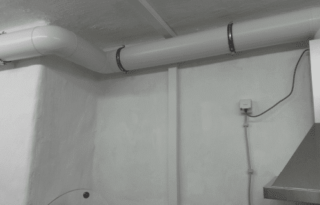
There are no completely silent exhaust devices, because they are powered by a motor. Some devices have not one, but two motors.
The noise level is influenced by several factors:
- Performance. A more powerful motor draws in air faster, so it makes noise when passing through the duct.
- The volume of the kitchen. The power must be selected in accordance with the volume of the kitchen, if it turns out to be too large, the appliance will make a noticeable noise.
- Duct diameter. According to the laws of physics, the same volume of air passes through a channel with a smaller section at a higher speed. The movement of the air flow causes extraneous sounds: the higher the speed, the louder the hum.
- The number of bends and transitions to the ventilation shaft. Obstacles on the way contribute to the appearance of extraneous noise. Bends at right or acute angles, transitions from one material to another, from rectangular to round, or vice versa, from large to small diameters, or vice versa - all these are the reasons for the increase in noise.
- Duct material. When choosing a material for the manufacture of a ventilation duct, you need to remember the rule: the smoother its walls are, the less noise the hood will emit during operation. If the duct does not need to be bent, smooth plastic is preferred over corrugation. If you need to lay the track at a right angle, corrugation is better, because it has a flexible, rounded body.
- Build quality. Loosely fastened parts vibrate during operation and therefore emit noise. Its level depends on the quality of the assembly and the quality of the wall mounting of the device and the duct.
The sound intensity depends on the specific model and is also determined by the manufacturer: the parameters are indicated in the technical data sheet.
What noise could there be
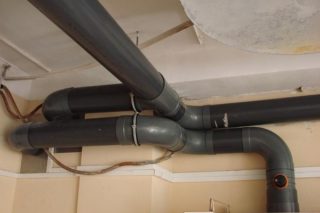
If the cooker hood makes a lot of noise, you need to determine if the noise is due to a breakdown. If the hood used to run quietly, and then began to hum, it is most likely broken. A malfunction is indicated by a hum, which intensifies over time, as well as vibration, rattling arising from backlash or broken off fragments inside the case.
Sound character:
- rattling and vibration - a sign of play in the exhaust mechanism, housing or duct;
- fan hum - breakage or contamination of the blades;
- whistling in the duct - leaks;
- buzzing in the duct - narrow section, high air speed, the presence of adapters and bends;
- engine noise - a powerful motor running at maximum speed or a sign of failure.
To make the hood in the kitchen quieter, you need to repair it yourself or contact a specialist.
Reducing exhaust noise
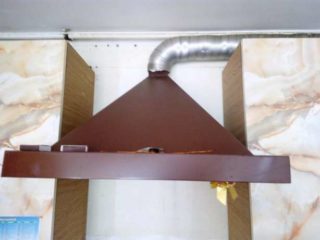
There are two ways to reduce the noise of the hood. The first is to carefully calculate the characteristics of the device in accordance with the volume of the kitchen, the distance to the ventilation shaft, and the installation height. The second is in observing the rules during installation and checking the fastening of all elements.
Usually inexpensive devices that are made of low-quality materials and assembled with errors make noise. If the hood is above average, the build quality is better and they are less noisy at the same power.
The performance of the device is selected taking into account the area of \ u200b \ u200bthe kitchen, but at the same time with a small margin so as not to turn on the hood at full capacity. Then the noise level will be acceptable. Formula for calculating optimal performance: Skitchen× Hsweat×12×1,3; Where Skitchen - kitchen area, Hsweat - ceiling height.
The diameter of the duct must correspond to the capacity of the exhaust. Recommendations are presented in the table:
| Exhaust power, m3 / h | Section, mm |
| 150-200 | 100 |
| 200-1000 | 150 |
| >1000 | >200 |
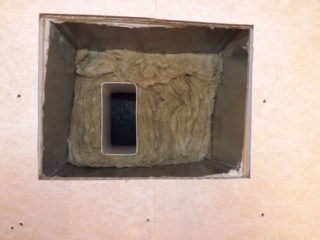
To make the cooker hood quieter, the cabinet in which it is built is pasted over with sound-absorbing materials, and the air duct is soundproofed. There are special sound absorbers for ventilation ducts, which look like separate fragments of it. They are made of noise-insulating materials and are installed in the channel gap. As a result, sound waves are damped, at the same time, there is no unnecessary load on the duct, and there is no obstacle to the air flow.
They try to make as few turns and transitions as possible or not do them at all. A right angle, if you cannot do without it, is rounded or divided into 2 angles at 45 degrees.
When installing the air duct, screeds and clamps, sealant are used. The hood is fixed tightly so that there is no backlash. Even a small gap between the wall and the appliance will cause vibration and noise. If there are extraneous sounds, the fasteners must be checked and tightened.
Observe the working height of the installation: for an electric stove - 60 cm, for a gas stove - 75–80 cm. If the distance is greater than the recommended one, the hood power must be increased, otherwise it will not perform its function properly. If you set it lower, the plastic parts will melt and they will make noise too.
DIY soundproofing
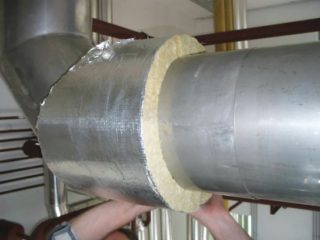
It is possible to soundproof the entire duct using roll materials. The noise isolator is selected depending on the place where it will be installed:
- mineral wool - for a steel air duct;
- polymeric materials such as polyethylene foam, polyurethane foam - for ventilation;
- organic sound insulators - for furniture with a built-in hood.
Installation is carried out using its own adhesive layer of material, using glue or by means of wire, clamps. In addition to installing noise insulation, it is recommended:
- install anti-vibration gaskets or springs under the fans, this will reduce the noise of the exhaust fan;
- replace the rectangular duct with a round one.
Special noise absorbers are inserted into the duct as a sleeve or adapter. At the same time, it is no longer necessary to paste over other sections of the duct with sound insulation. This is one of the most convenient and efficient sound insulation methods.
Rules for the reliable operation of the hood
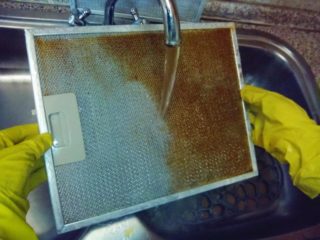
If the noise is not a feature of a particular model, it arises due to non-observance of the rules of operation and malfunction of the device. To repair the hood often, it is necessary:
- monitor the cleanliness of filters and hoods;
- do not leave the stove turned on without dishes;
- only touch the hood with clean hands;
- be treated with care.
Dirt and grease accumulated on the fan blades or filter increases the noise: the fan vibrates and the filter does not allow air to pass through, so you have to choose a more powerful mode. Dirt trapped in the air duct knocks, caught by the air flow. It is necessary to periodically clean the hood and, if necessary, also the air duct.
If the hood is noisy in the kitchen, you need to first find out the cause of the loud sound. The broken device is repaired, the vibrating elements are fixed. At home, it is advisable to do some work yourself. For example, installing soundproofing does not require special skills.








